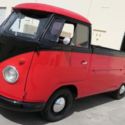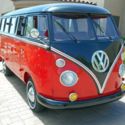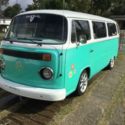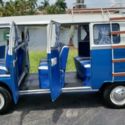1962 Volkswagen KOMBI BUS
- Location: Orlando, Florida, United States
- Condition: Used
- Make: Volkswagen
- Model: KOMBI BUS
- Type: --
- Trim: --
- Year: 1962
- Mileage: 39256
- VIN: 864777
- Color: --
- Engine size: 4 CYL
- Power options: --
- Fuel: Gasoline
- Transmission: 4 SPEED
- Drive type: --
- Interior color: Green
- Options: --
- Vehicle Title: Clear
1962 Volkswagen KOMBI BUS -- Description
The Volkswagen Type 2, known officially (depending on body type) as the Transporter, Kombi or Microbus, or, informally, as the Bus (US) or Camper (UK), is a forward control panel van introduced in 1950 by the German automaker Volkswagen as its second car model. Following - and initially deriving from Volkswagen's first model, the Type 1 (Beetle) - it was given the factory designation Type 2. As one of the forerunners of the modern cargo and passenger vans, the Type... 2 gave rise to forward control competitors in the United States in the 1960s, including the Ford Econoline, the Dodge A100, and the Chevrolet Corvair 95 Corvan, the latter adapting the rear-engine configuration of the Corvair car in the same manner in which the VW Type 2 adapted the Type 1 layout. The concept for the Type 2 is credited to Dutch Volkswagen importer Ben Pon. (It has similarities in concept to the 1920s Rumpler Tropfenwagen and 1930s Dymaxion car by Buckminster Fuller, neither of which reached production.) Pon visited Wolfsburg in 1946, intending to purchase Type 1s for import to the Netherlands, where he saw an improvised parts-mover and realized something better was possible using the stock Type 1 pan.5 #fn5 He first sketched the van in a doodle dated 23 April 1947, proposing a payload of 690 kg (1,520 lb) and placing the driver at the very front. Production would have to wait, however, as the factory was at capacity producing the Type 1.
 1962 Volkswagen Transporter Kombi 1600! West Coast Car! Clean!!!!!
1962 Volkswagen Transporter Kombi 1600! West Coast Car! Clean!!!!!
Mileage: 73,365
 1962 Volkswagen Type-2 Kombi 11-Window Bus 1600cc 4-Speed Manual
1962 Volkswagen Type-2 Kombi 11-Window Bus 1600cc 4-Speed Manual
Mileage: 4000
 VOLKSWAGEN KOMBI SPLIT 15 WINDOW BUS 1972 1967 1966 21 23 1965 1962 13 WALK VW
VOLKSWAGEN KOMBI SPLIT 15 WINDOW BUS 1972 1967 1966 21 23 1965 1962 13 WALK VW
Mileage: 111,111
 1962 Volkswagen bus kombi patina VW "van"
1962 Volkswagen bus kombi patina VW "van"
Mileage: 20,000
 VW Kombi Bus Grey 1962
VW Kombi Bus Grey 1962
Mileage: 50
 1975 Volkswagen bus/kombi
1975 Volkswagen bus/kombi
Mileage: 194,000
 1966 Volkswagen Kombi Bus
1966 Volkswagen Kombi Bus
Mileage: 68,277
 vw bus,15 window,kombi,vw,volkswagen bus
vw bus,15 window,kombi,vw,volkswagen bus
Mileage: 4,500
 1973 Volkswagen Kombi
1973 Volkswagen Kombi
Mileage: 100,000
 1975 Volkswagen Bus - Kombi
1975 Volkswagen Bus - Kombi
Mileage: 55000












